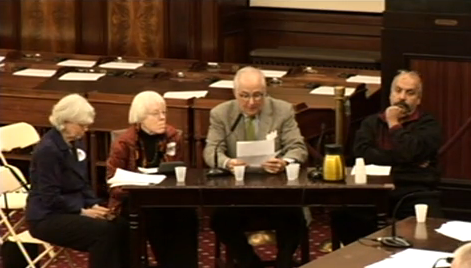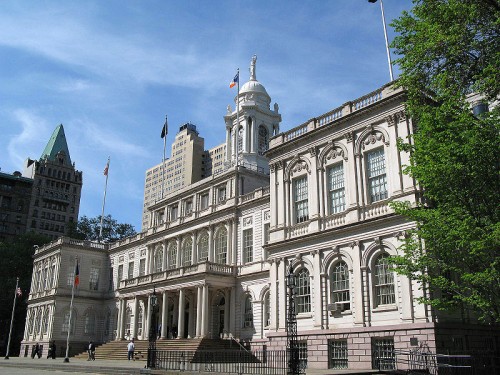Monthly Archives: December 2014
We’d like to thank everyone who attended last week’s City Council hearing. Below you can read a copy of the testimony we submitted before the Council. We are sending out copies to elected officials, and you can too!
We recommend sending a polite email to City Council Member Jimmy Van Bramer (jvanbramer@council.nyc.gov), Chair of the Committee of Cultural Affairs, and Council Speaker Melissa Mark-Viverito (mviverito@council.nyc.gov) encouraging them to read our testimony and work with us as we strive to make the library administration accountable to the people whose tax dollars fund our libraries. Simply download the PDF version and attach it in your email. You may also want to cc City Council Member Costa Constantinides (costa@council.nyc.gov), Chair of the Sub-Committee on Libraries.
Be sure to let them know that you want NYPL to conduct future capital projects with greater transparency, upgrade the climate controls in the 42nd Street library’s stacks, return the 3 million books that were exiled to storage in New Jersey, and abandon their misguided plan to sell the Science, Industry and Business library.
. . .
Testimony of Charles D. Warren of the Committee to Save the New York Public Library before the New York City Council Committee on Cultural Affairs, Libraries and International Intergroup Relations, jointly with the Subcommittee on Libraries. December 10, 2014
I am Charles Warren and I represent the Committee to Save the New York Public Library (CSNYPL), a citizens group that has sought to keep the popular Mid-Manhattan Branch as a library rather than a real estate deal, keep three million books in the stacks of the Central Library at 42nd Street, and maintain the Science Industry and Business Library (SIBL), the library closest to the CUNY Graduate Center.
With the support of thousands of New Yorkers, students, librarians, celebrated authors, union leaders, elected officials, and others we insisted that the $300 million price tag for the Central Library Plan (CLP), which escalated to $500 million, was too high. Thanks to our efforts and the elected officials who recognized the wasteful folly of this plan, we have stopped it.
The election of 2013 brought a new energy to our city government and the abandonment of NYPL’s destructive and extravagant Central Library Plan gives us all the opportunity to set a better course for the future. Base-line budgeting for the operating budgets of the three library systems is a positive step. And now, we welcome the opportunity to rethink the capital spending budget for our city’s libraries. As you know the many years of under-funding have left a pressing need for intelligent planning and stable funding.
The Center for an Urban Future has performed a great service in its careful study of the branch libraries and I want to add to that with some comments about what NYPL is calling the Midtown Campus, a scheme that encompasses its research library on 42nd Street and the popular Mid-Manhattan Library across 5th Avenue. I urge you to see that these two libraries are intertwined with and complimentary to the citywide network of neighborhood branches. Their central location and unique resources extend their importance beyond NYPL’s three borough system – they serve the whole city.
Public money and Private control – Is that a public/private partnership?
To citizens of New York it seemed the $151 Million contributed by New York City to the Central Library Plan was conjured from thin air; $100 Million from the Mayor; $50 Million from the City Council; $1 Million from the Manhattan Borough President. This money was granted when NYPL claimed it did not yet have even schematic designs. There were no public hearings, there was no public input. Now, most of this sum remains in the adopted FY 2015 capital budget. What is it for?
The NYPL Midtown Campus includes the Central Library at 42nd Street and the Mid-Manhattan Branch, but it fails to mention the Science Industry and Business Library, (SIBL) just a few blocks away.
Will the city council follow the old pattern where it grants $151 Million for a vaguely described plan being developed in secret? We need to know what our tax dollars are paying for. We must not stand for a partnership where the money is public and the decisions are private.
Just last week NYPL conducted a survey about plans for the Midtown Campus, but the survey omitted key questions. They did not ask:
• Does it make sense to leave the stacks empty for want of modern climate controls?
• Which Midtown Campus building is best suited to which library service?
• Should SIBL be sold or made part of the Midtown Campus?
• What balance should we strike between books and electronic services?
Instead, all the poll questions were skewed to avoid these important choices and reinforce a narrow set of pre-determined outcomes. This cannot be presented as meaningful public consultation.
If NYPL will not ask difficult questions, we must. And we must add a budget question: What is the best, most resilient, least destructive, and most economical way of achieving the public’s objectives for the library and the city? Long term capital plans should encompass all parts of all NYPL buildings.
Mistakes made with an insular process
NYPL is a not-for-profit corporation with a $1.1 Billion endowment. I often disagree with its president, Tony Marx, but I have no doubt that he is motivated by the same devotion to the library and the city that motivates the CSNYPL. I know the NYPL trustees are similarly well intentioned. We should applaud their extraordinary generosity and hard work. But insular decision-making at NYPL has led to a series of bad consequences:
•Ten years and countless millions wasted on the Central Library Plan.
• The fiasco of Donnell Library, where the anticipated real estate bonanza for NYPL has not been realized. Money from the sale of this beloved and busy neighborhood library has been chipped away at by bad deals, long delays, and millions spent to rent substitute space for years. In the end an irreplaceable neighborhood library of about 90,000 square feet will be replaced with a largely subterranean space 1/3 its size.
• SIBL was built at the cost of about $ 100 Million. It is a commercial condominium owned by NYPL, not by the city. But many costs associated with this facility were funded with NYS bonding authority. Should NYPL now be free to sell it without city approval? NYPL is now silent on the future of this huge investment in the “library of the future” (focused on CD-ROMs and an object lesson for those thinking they can predict the course of fast changing technology).
An on-going example of private planning with consequences for public funds is the Research Collections and Preservation Consortium (ReCAP) in Princeton, New Jersey. NYPL continues to spend its capital funds to construct and expand its remote storage facility there. These substantial capital investments are represented as “private funds.” and they are being made outside of New York City. Meanwhile, NYPL refuses to invest in its stacks, the uniquely efficient shelf system at the heart of its city owned 42nd Street building. Without public input, it has decided to leave the stacks empty, warehousing this space like a landlord waiting for an uptick in the real estate market.
Is it efficient to shuttle books back and forth from Princeton on a continuous basis? Is it environmentally responsible? Is it good for the preservation of the books? Is it good for New Yorkers? The answer seems to be that ReCAP is paid for with “private funds” and so it is not subject to city oversight. But “private funds” spent in New Jersey are dollars that are not spent on New York City facilities, and this means fewer jobs in New York. That leaves more needs to be met by city taxpayers and a bigger hole in the capital budget.
The public was barely consulted on these decisions, or consulted after they were set in motion. They have real consequences for library services and a real impact on the city’s capital expenditures. We need reform.
Make all information available to all
In order to make informed decisions about capital projects, the City Council and the public need access to cost and other information for past, present, and future projects. Decision-making is hobbled when public cost data are disclosed, but private cost data are concealed. NYPL leaders promise openness but fail to disclose important information.
For example: At the June 27, 2013 hearing before State Assembly Committee on Libraries, NYPL CEO Anthony Marx testified about CLP:
…. we understand that this plan needs an independent cost estimate and we will provide one as soon as we have an actual architectural design that can be assessed. We are as eager to [do] that as quickly as possible…., but we have to get it right. We also understand the public interest in having a cost estimate done by independent actors of what it would instead cost to make the current stacks work at state of the art preservation or for that matter to renovate the current Mid-Manhattan on site…. We will provide that information. We would love to do it sooner it looks at this point like we won’t have all of that complete till the fall. As soon as we have it we will make it public.
What was finally disclosed in the Wall Street Journal, as CLP was being scrapped, was that its cost had ballooned to $500 Million, that fitting out the unused storage under Bryant Park would cost $24 million (rather than the $8.5 Million NYPL estimated earlier) and that the cost to provide proper environmental controls in the stacks was estimated at $46 Million. No estimates were supplied for renovating the Mid-Manhattan Library, no professional cost-estimator was identified, nor was detail supplied. Indeed, the plans and specifications that formed the basis of these estimates have never been disclosed.
The failure of NYPL to fulfill its promise leaves the City Council and the public in the dark. We are deprived of important information and cost data needed to assess alternatives or estimate present capital plans for these buildings.
A closed book from an institution devoted to information access
Partial, selective disclosure of information is a pattern with NYPL. Its trustees’ meetings are open to the public, but much of the substance of those meetings is hidden within the briefing books provided to the trustees and not made public. I have asked Carey Maloney, the Speaker Mark-Viverito’s new representative to the NYPL trustees, to make his copy of these briefing books public, I have made the same request to the Comptroller’s staff. It should not require a quarterly Freedom of Information Act request to make public the substantive information underlying public meetings. Failure to disclose this information makes a mockery of open board meetings.
Pass-through contracts and NYC Department of Design and Construction
As this Committee knows, there are existing tools to require greater disclosure for the construction of city owned buildings. In a hearing held by this committee on April 28, 2014, the role of the NYC Department of Design and Construction (DDC) in library construction projects was examined. Testimony by Commissioner Peña-Mora and his deputy David Resnick emphasized the safe-guards and requirements for transparency in the DDC process. Under questioning, they compared this openness to the lack of transparency when pass-through contracts are used.
At the September 17, 2014 NYPL trustee meeting Anthony Marx claimed that pass-through contracts allowed the NYPL to deliver library projects at half the cost in half the time (compared to DDC). If this can be verified, it is a remarkable record of efficiency (even considering the lack of Wicks law requirements in pass-throughs contracts) and the city might want to fill vacancies at DDC from the staff of NYPL. But only NYPL has the data to support their claim.
We need to reform the rules for pass-through contracts so the use of some “private funds” does not cast a veil of secrecy over public building projects. I urge you to use the expertise within the DDC to find a more transparent process for these contracts. Absent greater transparency, our tax dollars are spent without sufficient public scrutiny or safe-guards.
Our Position on the capital budget
We support base-line budgeting. We support increased funding for NYPL and the other library systems. We support budget reform that allows for long term planning. These measures are needed to strengthen New York’s libraries.
But reform must accompany these increases and improvements in funding.
When we met with Peter Hatch from the Deputy Mayor’s office he indicated relations between the city and NYPL had entered a new era. But we cannot rely on better inter-personal relationships alone. With increased funding for operations and capital projects we must have greater openness, accountability, and transparency at NYPL. Citizens must be able to participate in decisions about both long and short term plans and we need mechanisms within the government to oversee library expenditures of both public and private funds. These libraries are our buildings. In return for more a more consistent stream of public funds, we must demand a more public planning process.
We urge the following reforms:
• Make increased and long-term capital funding contingent on greater openness and better oversight of NYPL.
• Require advance notice and periods of public comment on NYPL capital expenditures whether funded by the NYC or “privately” by NYPL.
• Reform pass-through contracts to provide better oversight and transparency.
• Use the government’s three appointed representatives as a conduit of information between the NYPL trustees and the public.
• Require a quarterly public report from the Speaker’s representative providing an independent account of NYPL plans.
• Require the disclosure of all information presented at NYPL trustee’s meetings.
• Require disclosure of past cost estimates relating to the Central Library Plan
Contact:
The Committee to Save the New York Public Library
232 East 11th Street
New York, NY 10003
info@saveNYPL.org
At 1:00 pm on December 10th, the NYC Council Committee on Cultural Affairs and the Sub-Committee on Libraries will hold a hearing on capital needs in the Council Chambers in City Hall (see attached). Charles Warren has been invited to testify on behalf of the Committee to Save NYPL. New York Public Library President Anthony Marx will also be testifying and is expected to request an unprecedented increase in capital funding for projects that will have profound effects for our branches and research libraries.
The hearing will be open to the public in the City Council Chamber, and we would like to encourage anyone interested in attending to join us as we demand a halt to the sale of the Science, Industry, and Business Library, the return of the three million books exiled from the 42nd Street library’s stacks, and greater accountability from NYPL leaders to the taxpayers who provide a large part of their funding.
For directions to City Hall, click here. In order to allow time to go through security, we recommend arriving at least 20 minutes in advanced of the hearing.
In addition to attending the public hearing this Wednesday, now is an excellent time to contact your local city council member and borough president. Let them know that the battle to save our libraries isn’t over, that the NYPL must be transparent and accountable to the public when it spends taxpayers’ money, and that this critical public hearing will shape the future of our libraries.
Manhattan Borough President Gale Brewer:
Email: info@manhattanbp.nyc.gov
Phone: (212) 669-8300
Bronx Borough President Rubén Díaz, Jr:
Email: webmail@bronxbp.nyc.gov
General Office: (718) 590-3500
Staten Island Borough President James S. Oddo:
Phone: (718) 816-2000
Email web form
And if you haven’t already participated in the NYPL’s user survey which will guide the Library’s plans for renovation of the 42nd St. and Mid-Manhattan Libraries, please do so here:
http://savenypl.org/nypl-
Appearing to engage library users, the New York Public Library has circulated an online survey to measure how the public uses their libraries. The results will inform their decisions about renovations to the Mid-Manhattan and 42nd Street libraries. Although the multiple choice format constrains complex answers, we recommend responding in ways that encourage the NYPL to return to 42nd Street the 3 million books that have been exiled.
Most of the questions fail to address the diverse needs of library patrons and ask participants to gauge library services according to rigid categories. We urge you to add your own comments wherever possible.
In spite of these shortcomings, we encourage everyone to take a few minutes to participate in the survey. Midway through the survey, you will be asked if you are willing to answer a few more questions. Make sure to answer “yes” since the questions that follow pertain to the Mid-Manhattan Library and the 42nd Street library.
At the end, a prompt will allow you to leave your comments. This is an excellent opportunity to tell NYPL to respect the integrity of Carrère and Hastings’s architecture, return the books to the stacks, and keep reading materials on-site so that both Mid-Manhattan Library and the 42nd Street library continue as the thought provoking center of New York.



